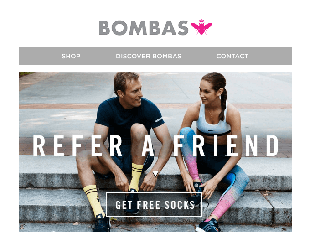As an e-commerce company, you want to reach as many people as possible and convert them into customers to generate revenue. But what happens when, despite your best efforts, revenue drops? Maybe cart abandonment is at an all-time high. Maybe conversion rates on cross-sell products are low. Maybe you attract buyers who don’t stick around.
Before budgeting for your next marketing campaign or paying for the advice of a sales consultant, try promoting a referral program with email marketing. Sending refer-a-friend emails engages your most loyal customers and asks them to bring you new customers. Their recommendations mean more to your future customers than any marketing campaign: 84% of customers rely on referrals to make purchase decisions. All you have to do is offer your customers something of value in return for their referral.
There are two approaches to referral email marketing. The first is to create and send brand new emails that ask customers to refer their friends and offer them a reward for doing so. But you don’t have to start from scratch. Adding a referral request to an existing email is effective as well.
Create dedicated refer-a-friend emails
Refer-a-friend emails have one job: to ask loyal customers to share their love for your products with other people. Referral-only emails get straight to the point and make it easy for readers to start sharing.
Bombas: Refer-a-friend email program invitation
The first step in promoting your referral program is to invite your customers to join it. These folks might be vaguely familiar with the current program or if the program’s new, people won’t know how it works yet.
When you send your own invitation email, make sure it explains the program and the benefits of participating.
The following invitation email from Bombas, a sock and apparel brand, does two things really well:
- Introduces the customer benefit early. The email makes sure the benefit is the first thing the reader sees – “Get free socks.” Bombas offers a premium product – one pair of socks costs as much as $22 – so free socks is an attractive offer.
- Explains how the program works. In five short steps, Bombas explains what customers have to do to get their feet into a free pair of socks.
Use your sales data to figure out which products customers buy the most, so you know what benefits to offer, and then give them what’s most popular. For example, categorize products based on the time of year they’re most popular. If you sell footwear, then a free pair of flip-flops in the summer may be appealing to your customers.
If you prefer to offer discounts, use previous promotional campaign data to find an amount that triggers referrals without sacrificing revenue growth. For example, the same footwear company may offer customers who share referrals a discount on boots in the winter.
Just like Bombas has done, list a few steps explaining the actions customers have to take. Break up your instructions with a short numbered list or use bullet points to explain. People don’t want to waste time scrolling or reading lots of text to find next steps. They’ll close the email before sharing a referral, which does nothing to boost revenue.
The invitation email is one of the most powerful referral emails you’ll send because it helps increase customer retention. The email offers a new and exciting opportunity customers weren’t aware of before, and many will take advantage if it means getting something valuable in return. People have to keep buying your products to reap the benefits of the program. Invesp, a company that helps brands improve conversion rates, found that increasing retention by as little as 5% lifts profits by 25-95%.
Uber Eats: Refer-a-friend email limited-time offer
Another way to get customers to share referrals is with emails that include an offer that expires.
Limited-time offers create a sense of urgency that gets people to act now vs. later. According to the psychology of loss aversion, people feel worse when they lose something compared to when they gain the same thing. A limited-time offer approach helps increase sales in the short term since it capitalizes on customers’ unwillingness to miss out on a good thing.
Uber Eats, a food delivery app, boosts short-term sales by asking advocates to share referrals during a weekend blitz. The email below also includes the “after promo” referral amount to show people what they’ll miss out on by waiting.
There are three main components your refer-a-friend emails need to create a sense of urgency and trigger sales:
- A captivating subject line. Referral marketing results in 3-5x higher conversion rates than other channels, but refer-a-friend emails have to be opened for that to happen. Use compelling phrases in the subject line to increase the open rate and the chance of conversion. For example, “Act now and get $25 towards your next purchase” gets customers to stop scrolling through their inbox and builds anticipation for the message.
- A short time frame. The amount of time people have to act determines the urgency – use short time frames like 1-2 days vs. 5-7 days. Limited-time offers usually consist of one-time promotions, so consider sending this type of email once or twice a quarter to stimulate sales.
- A relevant reward type. Refer-a-friend emails are effective when they offer value. Customers are eager to participate – and their referrals are more likely to buy – if they see something they want. Include examples of popular products that qualify for the offer, like Uber Eats does with sample restaurants. For customers in the market for a particular product, an email with an attractive offer and eye-catching images might be enough to push them to buy from you. Include product recommendations as well since they help increase cross-selling opportunities.
One thing the Uber Eats email doesn’t do is use more than one call to action (CTA). Depending on your email’s design – maybe you have lots of images, so readers have to scroll down to see them all – consider adding at least two CTAs. Make it easy for customers to follow through, so they click and share.
Athleta: Refer-a-friend email thank you
Another example of a referral-only email is the message sent to customers after they refer a friend. The primary message is “Thanks for sharing,” but the CTA asks for more referrals. So, it’s a hybrid referral-only email.
When customers share lots of referrals, you create a referral loop – a customer shares, gets a reward, feels good, so they share again, and the loop repeats itself. A strong referral loop keeps customers engaged and helps to steadily increase revenue.
Athleta, an activewear brand for women and girls, sends thank you emails that remind customers that once their referral buys something, the customer gets $20 off their next purchase. The message acts as a trigger for customers to follow up with their friends to ensure they both get rewarded.
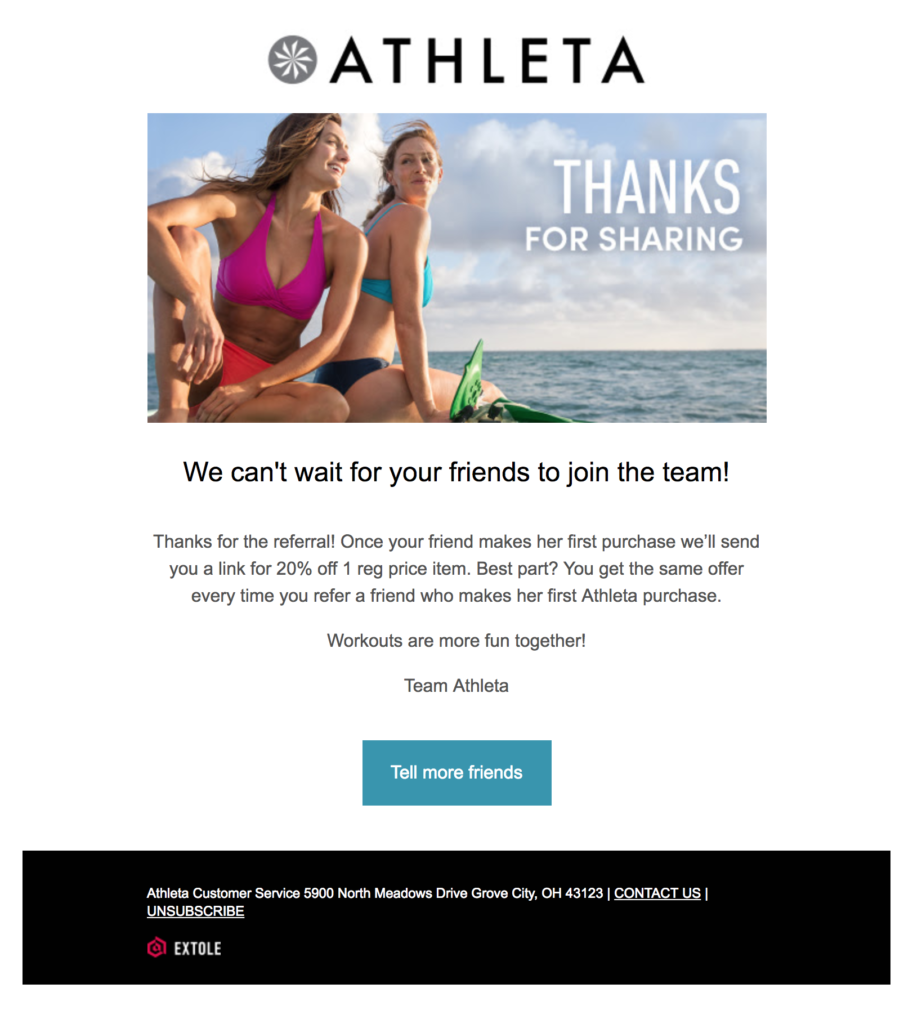
Increase sales potential by personalizing emails. Athleta’s email acknowledges that this particular customer’s referral code was shared with someone. The referred customer might have clicked on a referral code which sent an alert to Athleta’s customer management system.
People want personalization. By using your refer-a-friend emails to acknowledge something a customer’s done, you make them feel like part of your team. And in a way, they are – they’re directly responsible for a portion of your revenue growth. All you had to do was thank them and they keep referring friends and buying products. Not only does your revenue increase because of customer retention, but it also grows because of the constant stream of new customers being referred.
Send thank you emails immediately after customers share new referrals and while the experience is still fresh in customers’ minds. Further improve your chances of boosting revenue by including product recommendations or a re-order notification. Include text like, “It’s time to buy [product] again. Save 25% on your order when you refer another friend.”
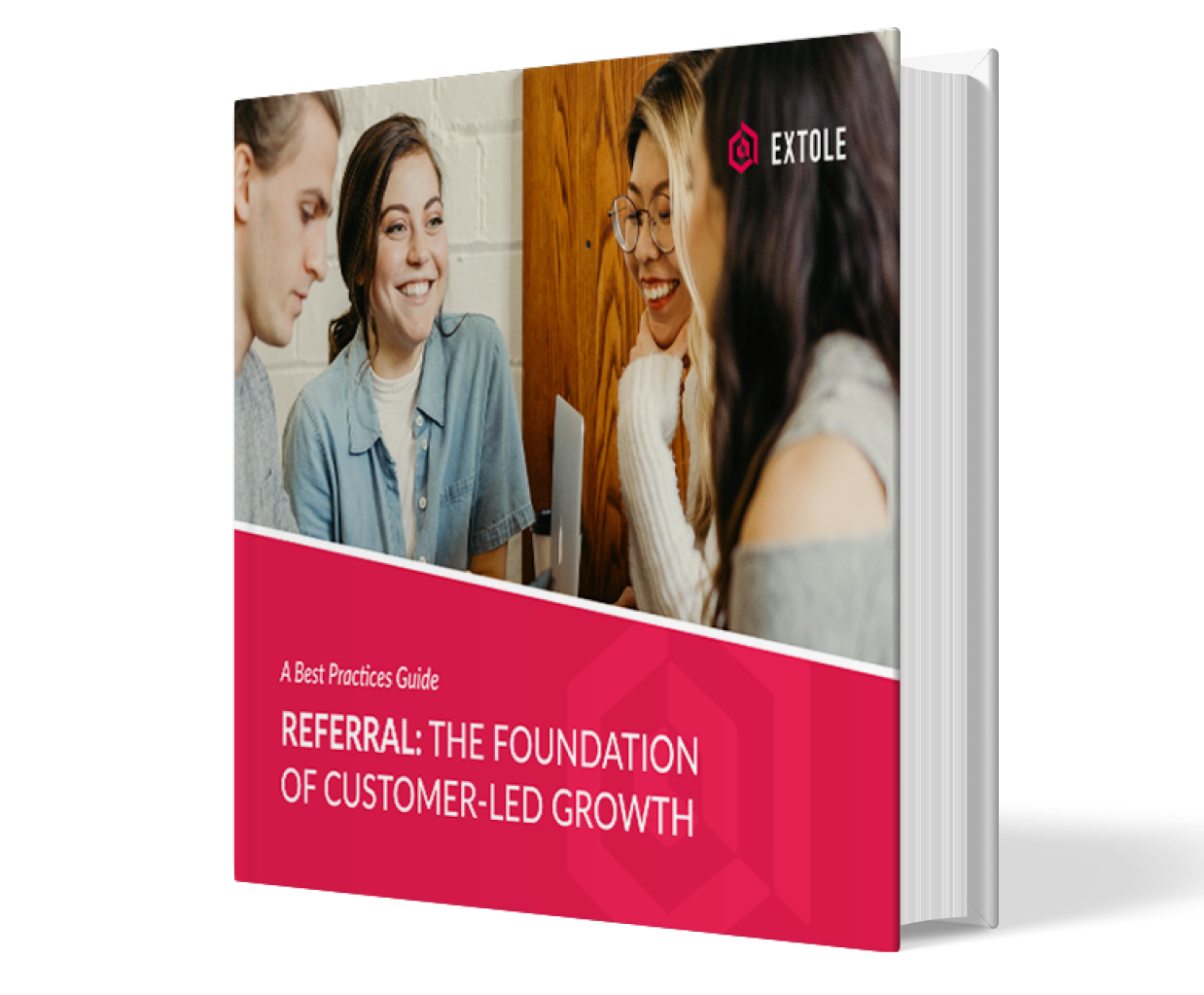
Referral Marketing – The Best Practices You Need to Know
Written by veteran referral marketers, this guide will help you optimize your referral marketing program and supercharge growth.
Add refer-a-friend prompts to existing emails
If you don’t want to build refer-a-friend email campaigns from scratch, then leverage existing marketing emails.
You save time since all you have to do is add a few lines of text about your referral program. The resulting email campaign acts as a subtle reminder for customers to share how much they love using your products.
Casper: review request + refer-a-friend email
Not all of your customers will share referrals the first time you invite them to, so they need an occasional reminder.
Reminders keep the program top of mind, so when people want to share, they don’t have to search through their email to find the original invite or scour your website looking for a link to share. The easier it is to find out how to refer and then follow through, the better your chances of increasing sales. For example, when you send requests for product reviews, tack on a referral reminder.
Casper, an online mattress company, includes a referral program reminder just below the body of the following review request email.
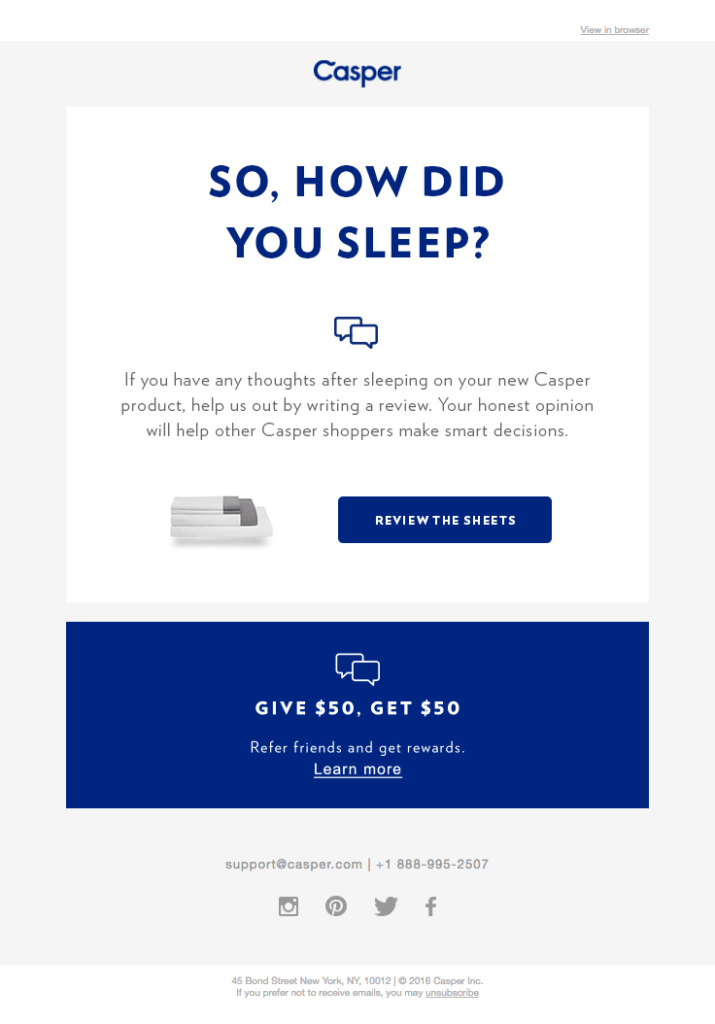
The idea here is if people have a good customer experience, they’re probably more willing to refer a friend.
Consider customer satisfaction levels when you choose which marketing emails to piggyback off of. Use emails that are sent after positive customer experiences – like a purchase confirmation email or a support ticket resolution email. You’ve got your customer’s attention, so make the value proposition clear. Use the same reward formula as Casper: “Give X, Get Y.”
Since the referral is part of another email, you don’t need a lot of copy to introduce it. Rather, get to the point quickly, so people aren’t distracted and tempted to click away. The less text you have, the less likely you are to lose sales because the click-through rate (CTR) is low. As an e-commerce company, a good CTR to aim for is 2.01% – the industry average. A solid CTR is one of the fastest ways to improve conversions and drive up revenue.
Another way to increase CTR is by playing with the email design. Casper’s email only uses two colors – white and blue – but the use of the blue block makes the referral stand out. Plus, the CTA isn’t even a button – it’s hyperlinked text. It stands out anyway because it’s action-oriented. Instead of a popular but boring “Click Here” approach, use “Learn More” or “Get Started Now” to get people excited and eager to click and refer.
TheSkimm & Dropbox: activity update + refer-a-friend email
If you have a rewards program, you probably send activity update emails often. The activity report, often gamified with scores and reward points, represents all the milestones customers have reached over a certain time frame. For really engaged customers, the report is the fuel they need to keep buying products and racking up points.
Activity updates are a great place to add in referral requests because they harness individuals’ desire to climb the reward ladder. The only difference from regular update emails is that customers are encouraged to share referrals to earn more rewards or discounts.
theSkimm, a daily newsletter, sends activity updates to its subscribers. Below is an example of an email that was sent to a subscriber for theSkimm’s fifth anniversary.
The email is personalized to include the recipient’s subscription length and usage time. It’s designed well because each stat has its own section. Readers can’t help but keep scrolling to find out what’s next. The last section references referrals. There’s a brief thank you note and details about the program. The incentive for people to share the newsletter is “presents.” One of the presents is $1,000! Not a bad incentive to motivate people to share referrals.
In another example of activity update emails, Dropbox sent the following activity update:
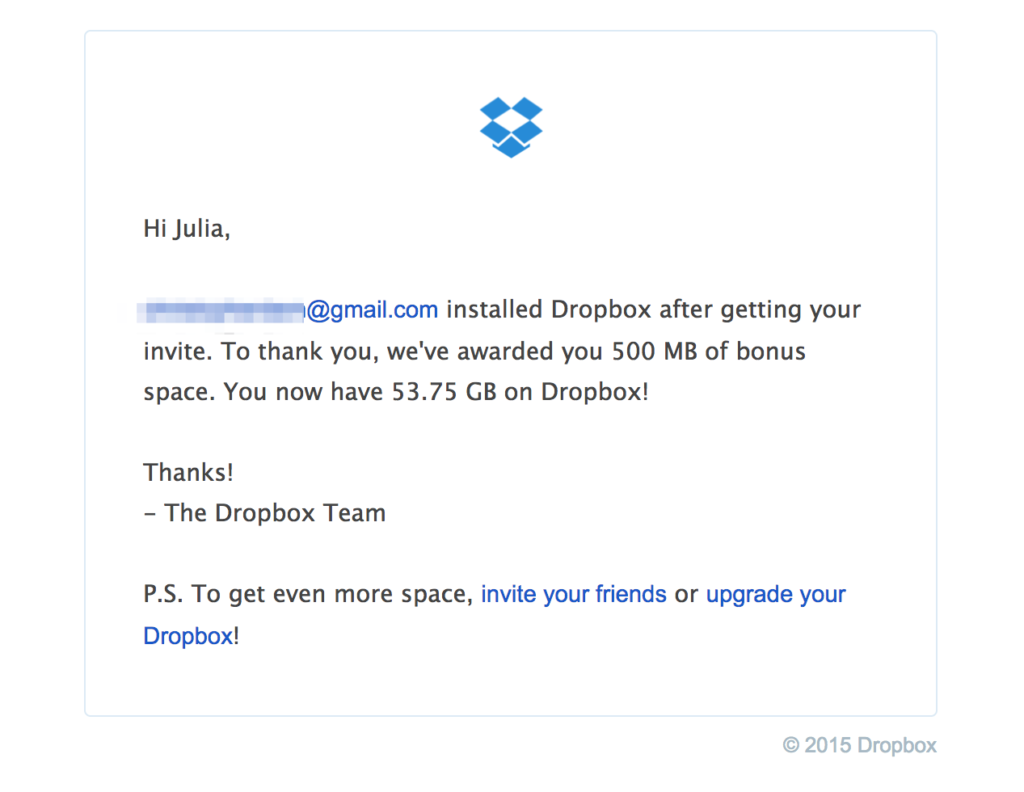
The text in this email is short, and the referral details also show up at the bottom – you can put yours anywhere in your email. The incentive in this case is extra storage space in return for referrals.
What both of these emails do well is incorporate elements of gamification – both emails reward individuals who make progress. Once folks reach a new level, they’re encouraged to get to the next one to receive even more rewards.
Gamification has a positive impact on sales because customers don’t feel like they’re being sold to. Their goal is to “win” as many prizes as possible, but in the process, they keep referring and buying more products. Your goal is to find the right reward incentive. Test whether your audience values free stuff, points, or discounts, then use your activity update to explain how to get them.
Consider adding other gamification elements:
- A leaderboard. Show the top 10 or 20 highest referrers and incentivize customers to get a new “high score.”
- A progress bar. If you offer different referral reward tiers, show people how close they are to the next level. Add in bonus benefits like free shipping or free product samples.
- Referral stats. Include the date of the first referral, how many referrals have been made since, total referrals who’ve followed through, and how much money the referrals and the advocate have received. Encourage repeat referrals to boost revenue.
Continue to test different gamification elements to figure out what information people find relevant and motivating. After you send each email campaign, review the impact increased customer engagement had on sales. Did sales go up, or are they still dropping? Make adjustments and send another campaign.
Set up refer-a-friend emails
Once you decide on the type of referral emails you’ll send – either brand new communications about the referral program or referral messages piggybacked onto existing customer emails – use an email messaging tool like Mailchimp to automatically send emails after defined customer actions. For example, send emails at specific points along the customer journey, so customers are reminded to keep sharing.
Once you have a referral process in place, focus on improving new customers’ experience. New customers who are referred to you by existing ones trust your brand more than new customers who are completely new to your store. Nurture referred customers to retain them, and they’ll eventually be ready to share referrals as well. Revenue will recover as you continue to onboard new customers and retain current ones longer.
